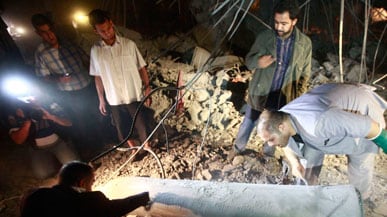The type of NATO airstrike that took out Saif Gaddafi requires precise knowledge of the target's location. Clive Irving on what the killing reveals about NATO's on-the-ground intelligence—and its view of ending the war in Libya. Plus, was the attack exaggerated?
The attack that killed Saif Gaddafi, Colonel Muammar Gaddafi's youngest son, has all the hallmarks of a called-in strike.
This kind of attack is time-sensitive: it requires knowing precisely when and where a target is going to be. It seems that Gaddafi and his wife were on a family visit, venturing from their normally secure quarters after nightfall.

U.N. resolution 1973, which covers NATO action in Libya, has a particularly flexible mandate: to use "all necessary measures" to protect Libyans. But NATO spokesmen have repeatedly said this resolution does not allow the targeting of Colonel Gaddafi.
In the last two weeks both the CIA and the British SAS have sent in "advisers" whose task was said to be to achieve greater coordination between NATO air forces and the rebels on the ground. This strike in Tripoli is, however, clearly well outside that role.
At the very least, it indicates that Gaddafi's own movements—flitting between "bunkers" and other locations—are being tracked with a precision that indicates a high level of intelligence on the ground. Why else hit his son's house, which is not covered even by that conveniently nebulous definition "command and control"?
Getting within one wall of actually killing Gaddafi himself is pretty close to signaling what is really obvious: The best way of ending this war is to decapitate the Libyan regime.
Called-in strikes usually involve drones. After repeated requests from NATO, the U.S. assigned two Predator drones to the Libyan theater. Unlike NATO jets, which can take at least 45 minutes from being scrambled to being able to find a target, drones can loiter over Libya for many hours before being given targets. And when they get a time-critical target they can act within seconds.
This attack reveals a lot about NATO's new targeting priorities and the quality of its intelligence. It also raises a larger issue of targeting policy. Getting within one wall of actually killing Gaddafi himself is pretty close to signaling what is really obvious: The best way of ending this war is to decapitate the Libyan regime.
Clive Irving is senior consulting editor at Conde Nast Traveler, specializing in aviation—find his blog, Clive Alive, at CliveAlive.Truth.Travel.






